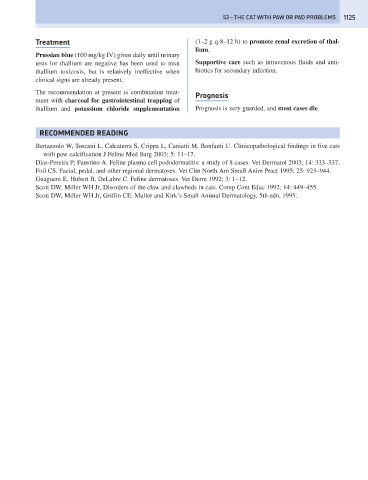Page 1133 - Problem-Based Feline Medicine
P. 1133
53 – THE CAT WITH PAW OR PAD PROBLEMS 1125
Treatment (1–2 g q 8–12 h) to promote renal excretion of thal-
lium.
Prussian blue (100 mg/kg IV) given daily until urinary
tests for thallium are negative has been used to treat Supportive care such as intravenous fluids and anti-
thallium toxicosis, but is relatively ineffective when biotics for secondary infection.
clinical signs are already present.
The recommendation at present is combination treat- Prognosis
ment with charcoal for gastrointestinal trapping of
thallium and potassium chloride supplementation Prognosis is very guarded, and most cases die.
RECOMMENDED READING
Bertazzolo W, Toscani L, Calcaterra S, Crippa L, Caniatti M, Bonfanti U. Clinicopathological findings in five cats
with paw calcification J Feline Med Surg 2003; 5: 11–17.
Dias-Pereira P; Faustino A. Feline plasma cell pododermatitis: a study of 8 cases. Vet Dermatol 2003; 14: 333–337.
Foil CS. Facial, pedal, and other regional dermatoses. Vet Clin North Am Small Anim Pract 1995; 25: 923–944.
Guaguere E, Hubert B, DeLabre C. Feline dermatoses. Vet Derm 1992; 3: 1–12.
Scott DW, Miller WH Jr, Disorders of the claw and clawbeds in cats. Comp Cont Educ 1992; 14: 449–455.
Scott DW, Miller WH Jr, Griffin CE. Muller and Kirk’s Small Animal Dermatology, 5th edn. 1995.

